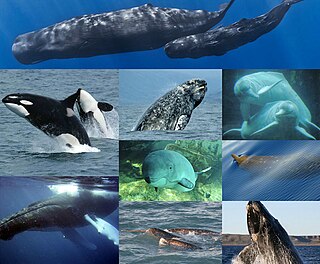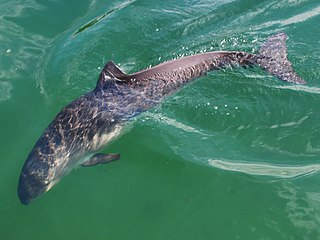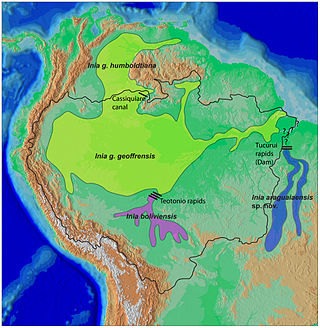Related Research Articles

Cetacea is an infraorder of aquatic mammals belonging to the order Artiodactyla that includes whales, dolphins, and porpoises. Key characteristics are their fully aquatic lifestyle, streamlined body shape, often large size and exclusively carnivorous diet. They propel themselves through the water with powerful up-and-down movement of their tail which ends in a paddle-like fluke, using their flipper-shaped forelimbs to maneuver.

A dolphin is an aquatic mammal within the infraorder Cetacea. Dolphin species belong to the families Delphinidae, Platanistidae, Iniidae, Pontoporiidae, and possibly extinct Lipotidae. There are 40 extant species named as dolphins.

Porpoises are small dolphin-like cetaceans classified under the family Phocoenidae. Although similar in appearance to dolphins, they are more closely related to narwhals and belugas than to the true dolphins. There are eight extant species of porpoise, all among the smallest of the toothed whales. Porpoises are distinguished from dolphins by their flattened, spade-shaped teeth distinct from the conical teeth of dolphins, and lack of a pronounced beak, although some dolphins also lack a pronounced beak. Porpoises, and other cetaceans, belong to the clade Cetartiodactyla with even-toed ungulates.

River dolphins are a polyphyletic group of fully aquatic mammals that reside exclusively in freshwater or brackish water. They are an informal grouping of dolphins, which itself is a paraphyletic group within the infraorder Cetacea. Extant river dolphins are placed in two superfamilies, Platanistoidea and Inioidea. They comprise the families Platanistidae, the recently extinct Lipotidae, Iniidae and Pontoporiidae. There are five extant species of river dolphins. River dolphins, alongside other cetaceans, belong to the clade Artiodactyla, with even-toed ungulates, and their closest living relatives the hippopotamuses, from which they diverged about 40 million years ago. Specific types of dolphins can be pink.

The toothed whales are a parvorder of cetaceans that includes dolphins, porpoises, and all other whales possessing teeth, such as the beaked whales and sperm whales. 73 species of toothed whales are described. They are one of two living groups of cetaceans, the other being the baleen whales (Mysticeti), which have baleen instead of teeth. The two groups are thought to have diverged around 34 million years ago (mya).

Cetacean intelligence is the overall intelligence and derived cognitive ability of aquatic mammals belonging in the infraorder Cetacea (cetaceans), including baleen whales, porpoises, and dolphins. In 2014, a study found for first time that the long-finned pilot whale has more neocortical neurons than any mammal studied to date, including humans.

Cetacean surfacing behaviour is a grouping of movement types that cetaceans make at the water's surface in addition to breathing. Cetaceans have developed and use surface behaviours for many functions such as display, feeding and communication. All regularly observed members of the order Cetacea, including whales, dolphins and porpoises, show a range of surfacing behaviours.

Cetacean stranding, commonly known as beaching, is a phenomenon in which whales and dolphins strand themselves on land, usually on a beach. Beached whales often die due to dehydration, collapsing under their own weight, or drowning when high tide covers the blowhole. Cetacean stranding has occurred since before recorded history.

The Vancouver Aquarium is a public aquarium located in Stanley Park in Vancouver, British Columbia, Canada. In addition to being a major tourist attraction for Vancouver, the aquarium is a centre for marine research, ocean literacy education, climate activism, conservation and marine animal rehabilitation.
The U.S. Navy Marine Mammal Program (NMMP) is a program administered by the U.S. Navy which studies the military use of marine mammals - principally bottlenose dolphins and California sea lions - and trains animals to perform tasks such as ship and harbor protection, mine detection and clearance, and equipment recovery. The program is based in San Diego, California, where animals are housed and trained on an ongoing basis. NMMP animal teams have been deployed for use in combat zones, such as during the Vietnam War and the Iraq War.

The 1992 cageless shark-diving expedition was the world's first recorded intentionally cageless dive with great white sharks, contributing to a change in public opinions about the supposed ferocity of these animals.

The River Thames whale, affectionately nicknamed Willy by Londoners, was a juvenile female northern bottlenose whale which was discovered swimming in the River Thames in central London on Friday 20 January 2006. According to the BBC, she was five metres (16-18ft) long and weighed about twelve tonnes (24,400 lb). The whale appeared to have been lost, as her normal habitat would have been around the coasts of the far north of Scotland and Northern Ireland, and in the seas around the Arctic Ocean. It was the first time the species had been seen in the Thames since records began in 1913. She died from convulsions as she was being rescued shortly after 19:00 GMT on 21 January 2006.

British Divers Marine Life Rescue (BDMLR) is a British charity established in 1988 and is a frontline marine mammal response organisation. It utilises a network of trained volunteers around the country to respond to marine mammals potentially in need of assistance via a public 24hr hotline and callout system. The organisation's main areas of operation are in the United Kingdom and its territorial waters; however, the charity has received requests from Canada, the Falkland Islands, Kenya, Ireland, Italy, Kazakhstan, Malta and Abu Dhabi.

The Marine Mammal Center (TMMC) is a private, non-profit U.S. organization that was established in 1975 for the purpose of rescuing, rehabilitating and releasing marine mammals who are injured, ill or abandoned. It was founded in Sausalito, California, by Lloyd Smalley, Pat Arrigoni and Paul Maxwell. Since 1975, TMMC has rescued over 24,000 marine mammals. It also serves as a center for environmental research and education regarding marine mammals, namely cetaceans, pinnipeds, otters and sirenians. Marine mammal abandonment refers to maternal separation; pups that have been separated from their mother before weaning. At the center, they receive specialized veterinary care: they are diagnosed, treated, rehabilitated and ideally, released back into the wild. Animals in need of assistance are usually identified by a member of the public who has contacted the center. These animals represent the following major species: California sea lions, northern elephant seals, Pacific harbor seals, northern fur seals, Guadalupe fur seals, Hawaiian monk seals, and southern sea otters. On a few occasions, TMMC has taken in Steller sea lions and bottlenose/Pacific white-sided dolphins. The only non-mammals that TMMC takes in are sea turtles.
Tião was a solitary male bottlenose dolphin that was first spotted in the town of São Sebastião in Brazil around 1994 and frequently allowed humans to interact with him, having a particular preference to interacting with female humans. The dolphin later killed a swimmer and injured many others, which later earned him the nickname killer dolphin.
Marine Connection is a London, UK-based animal welfare charity working both nationally and internationally for the welfare, protection, and conservation of cetaceans: dolphins, whales and porpoises. The charity aims to achieve its objectives via various campaigns, educational and research programmes; events and press coverage. It also encourages the general public, private companies and celebrities to become involved.

Dolphin Tale is a 2011 American 3D family drama film directed by Charles Martin Smith, from a screenplay by Karen Janszen and Noam Dromi and a book of the same name. It stars Harry Connick Jr., Ashley Judd, Nathan Gamble, Kris Kristofferson, Cozi Zuehlsdorff in her film debut, and Morgan Freeman. The book and film are inspired by the true story of Winter, a bottlenose dolphin that was rescued in December 2005 off the Florida coast and taken in by the Clearwater Marine Aquarium. In the film, Winter loses her tail after becoming entangled with a rope attached to a crab trap, and must be fitted with a prosthetic one in order to swim naturally again.

Clearwater Marine Aquarium is a 501(c)(3) non-profit organization, and aquarium in Clearwater, Florida. It is dedicated to the rescue, rehabilitation and release of sick and injured marine animals, public education, conservation, and research.

Fungie, also known as the Dingle Dolphin, was a male common bottlenose dolphin. He became separated from other wild dolphins and lived in very close contact with the people of Dingle on the southwest coast of Ireland.
Benny is a beluga whale that made headlines in the United Kingdom in September 2018 after being sighted travelling towards London through the Thames Estuary. Benny was sighted several times over the ensuing weeks after his discovery in the Estuary, and appears to be healthy despite appearing alone.
References
- ↑ Solitary Sociable Dolphins, an update from the UK; by Mark Simmonds
- ↑ "Marine Connection: The Solitary dolphin phenomenon". Archived from the original on 2008-08-30. Retrieved 2008-03-05.
- ↑ Dolphin hit by boat propeller
- ↑ Concern for missing Kent dolphin
- ↑ Article about injury and treatment
- ↑ Still no sign of Dave the dolphin
- ↑ Press release from BDMLR, Marine Connection,and WDCS: Dave missing and feared dead [ permanent dead link ]
- ↑ Tougher laws needed to protect friendly dolphins
- ↑ Newspaper article: Zoologist claims Dave the dolphin is a girl
- ↑ Pair charged over dolphin actions
- ↑ Kent Online newspaper article on court case